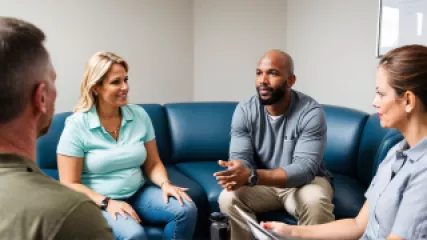A Step-by-Step Guide to Veteran Mental Health Therapy
A Step-by-Step Guide to Veteran Mental Health Therapy
As a veteran, prioritizing your mental health can be a crucial step in your journey towards healing, growth, and overall well-being. Whether you've experienced the challenges of combat, the stress of military life, or the difficulties of adjusting to civilian life, seeking professional mental health support can make a significant difference. In this comprehensive guide, we'll walk you through the process of accessing and engaging in veteran mental health therapy, with the goal of helping you find the resources and support you need to thrive.
Understanding the Importance of Mental Health Care for Veterans
Veterans often face unique mental health challenges, from post-traumatic stress disorder (PTSD) to anxiety, depression, and substance abuse. These conditions can have a profound impact on various aspects of your life, including your relationships, career, and overall quality of life. Seeking professional mental health therapy can provide you with the tools and support you need to manage these challenges, improve your well-being, and enhance your ability to transition successfully to civilian life.
It's important to understand that reaching out for help is a sign of strength, not weakness. Mental health challenges are common among veterans, and there is no shame in seeking the support you need. In fact, taking the first step towards accessing therapy can be one of the most courageous decisions you can make for your overall health and well-being.
Identifying the Types of Veteran Mental Health Therapy Available
When it comes to veteran mental health therapy, there are a variety of approaches and modalities to choose from, each with its own unique benefits and considerations. Some of the most common types of therapy for veterans include:
Cognitive-Behavioral Therapy (CBT)
CBT is a highly effective, evidence-based approach that helps individuals identify and modify negative thought patterns and behaviors that contribute to mental health challenges. This type of therapy focuses on developing practical coping strategies and techniques to manage PTSD, anxiety, depression, and other mental health concerns.
Prolonged Exposure Therapy (PE)
PE is a specialized form of CBT that helps individuals confront and process traumatic memories in a safe and controlled environment. This approach is particularly effective in treating PTSD, as it allows veterans to gradually overcome their fear and anxiety associated with the traumatic event(s).
Eye Movement Desensitization and Reprocessing (EMDR)
EMDR is a trauma-focused therapy that uses rapid eye movements or other forms of bilateral stimulation to help individuals process and integrate traumatic memories. This approach can be highly effective in reducing the intensity of PTSD symptoms and improving overall emotional well-being.
Group Therapy
Group therapy provides a supportive and collaborative environment where veterans can share their experiences, learn from one another, and develop coping strategies together. This approach can be particularly beneficial for veterans who may feel isolated or struggle to connect with others who have not had similar experiences.
Family Therapy
Family therapy involves working with your loved ones to improve communication, strengthen relationships, and address the impact of mental health challenges on the family unit. This approach can be invaluable for veterans who are navigating the complexities of reintegrating into civilian life and rebuilding relationships with their families.
Accessing Veteran Mental Health Therapy
Accessing veteran mental health therapy can be a daunting process, but there are several resources and support systems available to help you along the way. Here's a step-by-step guide to getting started:
Step 1: Understand Your Benefits
As a veteran, you may have access to various mental health services and resources through the U.S. Department of Veterans Affairs (VA) or your private health insurance provider. Take the time to research and understand the mental health benefits available to you, including any co-pays, deductibles, or limitations on the number of sessions covered.
Step 2: Reach Out to the VA
The VA is a valuable resource for veteran mental health services, offering a wide range of therapies and support programs. To access VA mental health care, you can start by contacting your local VA medical center or community-based outpatient clinic. The VA can also connect you with community-based providers if you prefer to seek care outside of the VA system.
Step 3: Explore Community-Based Options
In addition to the VA, there are many community-based mental health providers and organizations that specialize in serving the veteran population. These may include private therapists, counseling centers, or non-profit organizations dedicated to supporting veterans' mental health. You can search for providers in your area through online directories, referrals from your primary care physician, or by contacting local veterans' organizations.
Step 4: Schedule an Initial Appointment
Once you've identified a mental health provider, the next step is to schedule an initial appointment. During this first session, you'll have the opportunity to discuss your mental health concerns, goals, and preferences for treatment. The therapist will also gather information about your background, military service, and any mental health history to help develop a personalized treatment plan.
Step 5: Be an Active Participant in Your Care
Engaging in mental health therapy is a collaborative process, and it's important to be an active participant in your own care. This may involve completing homework assignments, practicing coping techniques between sessions, and providing honest feedback to your therapist about what's working and what's not. By taking an active role, you can maximize the benefits of your therapy and work towards achieving your mental health goals.
What to Expect During Veteran Mental Health Therapy
Entering into mental health therapy can be a daunting prospect, but understanding what to expect can help ease any concerns or anxiety you may have. Here's a general overview of what you can expect during the therapy process:
Initial Assessment and Treatment Planning
During your first session, your therapist will gather information about your background, military service, mental health history, and current concerns. They will use this information to develop a personalized treatment plan that addresses your unique needs and goals.
Establishing a Therapeutic Relationship
Effective therapy is built on a foundation of trust, respect, and open communication between the client and the therapist. Your therapist will work to create a safe, non-judgmental environment where you feel comfortable sharing your experiences and emotions.
Exploring and Addressing Trauma
For many veterans, the process of therapy may involve delving into traumatic experiences from their military service. This can be a difficult and emotional process, but your therapist will guide you through it with care and support, using evidence-based techniques to help you process and integrate these experiences.
Learning Coping Strategies
A key aspect of mental health therapy is developing practical coping strategies and skills to manage your mental health challenges. This may include techniques like deep breathing, mindfulness, cognitive restructuring, and emotion regulation.
Setting and Achieving Goals
Throughout the therapy process, you and your therapist will work together to set achievable goals and track your progress. This could include improving relationships, finding a fulfilling career, or simply feeling more in control of your thoughts and emotions.
Ongoing Support and Maintenance
Mental health therapy is not a one-time event, but rather an ongoing journey. Even after achieving your initial goals, your therapist can provide continued support and guidance to help you maintain your progress and resilience in the face of future challenges.
Overcoming Barriers and Challenges
While seeking mental health therapy can be a transformative experience, it's important to acknowledge that there may be barriers and challenges along the way. Here are some common obstacles and strategies for addressing them:
Stigma and Misconceptions
There is often a stigma associated with seeking mental health support, particularly within the military community. It's important to remember that taking care of your mental health is a sign of strength, not weakness. Your therapist can help you navigate and challenge any negative preconceptions you or others may have about mental health treatment.
Accessibility and Cost
Access to affordable mental health care can be a significant barrier for some veterans. However, there are resources available to help you overcome these challenges, such as the VA's mental health services, community-based organizations that offer sliding-scale fees, and the use of telehealth options for remote therapy sessions.
Resistance to Change
Engaging in mental health therapy can be a transformative but also challenging process. You may encounter resistance or ambivalence about making changes in your thoughts, behaviors, and coping strategies. Your therapist can help you navigate these feelings and provide the support and encouragement you need to stay motivated and committed to your treatment.
Trust and Vulnerability
Sharing deeply personal experiences and emotions with a therapist can be difficult, especially for veterans who may be accustomed to maintaining a stoic or self-reliant demeanor. Your therapist will work to create a safe and non-judgmental environment, but it's also important to be patient with yourself as you learn to open up and build trust.
Balancing Therapy with Other Responsibilities
As a veteran, you may have a variety of responsibilities and obligations that can make it challenging to prioritize and commit to regular therapy sessions. Your therapist can work with you to develop a schedule and treatment plan that fits within your lifestyle and helps you maintain consistency in your care.
Maintaining Mental Health after Therapy
The journey of mental health recovery doesn't end with the completion of therapy. Maintaining your mental health and well-being requires ongoing self-care, support, and a commitment to the strategies and skills you've developed during your treatment. Here are some tips for continuing your mental health journey after therapy:
Develop a Self-Care Routine
Engage in regular self-care activities that nourish your mind, body, and spirit, such as exercise, mindfulness practices, journaling, or pursuing hobbies and passions. These activities can help you maintain the progress you've made in therapy and proactively manage your mental health.
Stay Connected to Your Support System
Maintain strong connections with your loved ones, fellow veterans, and any support groups or communities you've found meaningful during your therapy process. These relationships can provide the ongoing encouragement, understanding, and accountability you need to stay on track with your mental health goals.
Utilize Ongoing Resources and Checkups
Consider scheduling regular check-ins with your therapist or mental health provider, even if it's just a periodic session to ensure you're maintaining your progress. You can also explore ongoing support groups, workshops, or other resources that can help you continue to build resilience and coping skills.
Embrace a Lifelong Commitment to Mental Health
Recognizing that mental health is a lifelong journey, not a destination, can help you approach your continued self-care with compassion, patience, and a willingness to adapt as your needs evolve over time. By prioritizing your mental well-being, you'll be better equipped to navigate the ups and downs of life and maintain a sense of purpose, fulfillment, and resilience.
Conclusion
Seeking mental health therapy as a veteran is a profound act of self-care and a testament to your strength and resilience. By engaging in this transformative process, you can learn to manage the unique challenges you've faced, develop effective coping strategies, and ultimately, reclaim your sense of purpose, connection, and overall well-being. Remember, you are not alone in this journey, and there are countless resources and supportive communities available to guide you every step of the way. Take the first step today, and embrace the opportunity to invest in your mental health – your future self will thank you.






